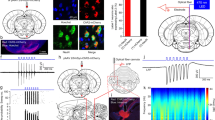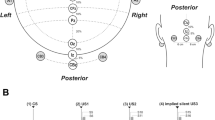Abstract
A large body of evidence indicates that the cerebellum is essential for the acquisition, retention, and expression of the standard delay conditioned eyeblink response and that the basic memory trace appears to be established in the anterior interpositus nucleus (IP). Adaptive timing of the conditioned response (CR) is a prominent feature of classical conditioning—the CR peaks at the time of onset of the unconditioned stimulus (US) over a wide range of CS-US interstimulus intervals (ISI). A key issue is whether this timing is established by the cerebellar circuitry or prior to the cerebellum. In this study timing of conditioned eyeblink responses established via electrical stimulation of the interpositus nucleus as a conditioned stimulus (CS) was analyzed prior to and following modification of the CS-US interval in well-trained rabbits. Consistent with previous results, learning under these conditions is very rapid and robust. The CR peak eyeblink latencies are initially timed to the US onset and adjust accordingly to lengthening or shortening of the CS-US interval, just as with peripheral CSs. The acquisition of conditioned eyeblink responses by direct electrical stimulation of the IP as a CS thus retains temporal flexibility following shifts in the CS-US delay, as found in standard classical eyeblink conditioning procedures.
Similar content being viewed by others
References
Bao, S., Chen, L., Kim, J.J., & Thompson, R.F. (2002). Cerebellar cortical inhibition and classical eyeblink conditioning.Proceedings of the National Academy of Sciences USA, 99(3), 1592–1597.
Bao, S., Chen, L., & Thompson, R.F. (2000). Learning—and cerebellum-dependent neuronal activity in the lateral pontine nucleus.Behavioral Neuroscience, 114(2), 254–261.
Berthier, N.E., & Moore, J.W. (1986). Cerebellar Purkinje cell activity related to the classically conditioned nictitating membrane response.Experimental Brain Research, 63(2), 341–350.
Black-Cleworth, P., Woody, C.D., & Niemann, J. (1975). A conditioned eyeblink obtained by using electrical stimulation of the facial nerve as the unconditioned stimulus.Brain Research, 90(1), 45–56.
Brogden, W.J. & Gantt, W.H. (1942) Intraneural conditioning: cerebellar conditioned reflexes.Archives of Neurological Psychology, 48, 437–455.
Cegavske, C.F., & Thompson, R.F. (1976). Mechanisms of efferent neuronal control of the reflex nicitating membrane response in rabbit (Oryctolagus cuniculus).Journal of Comparative Physiological Psychology, 90(5), 411–423.
Chapman, P.F., Steinmetz, J.E., & Thompson, R.F. (1988). Classical conditioning does not occur when direct stimulation of the red nucleus or cerebellar nuclei is the unconditioned stimulus.Brain Research, 442(1), 97–104.
Chen, L., Bao, S., Lockard, J.M., Kim, J.K., & Thompson, R.F. (1996). Impaired classical eyeblink conditioning in cerebellar-lesioned and Purkinje cell degeneration (pcd) mutant mice.Journal of Neuroscience, 16(8), 2829–2838.
Christian, K., & Thompson, R.F. (2003). Neural substrates of eyeblink conditioning: acquisition and retention.Learning and Memory, 10, 427–455.
Clark, G.A., McCormick, D.A., Lavond, D.G., & Thompson, R.F. (1984). Effects of lesions of cerebellar nuclei on conditioned behavioral and hippocampal neuronal responses.Brain Research, 291(1), 125–136.
Clark, R.E., & Lavond, D.G. (1996). Neural unit activity in the trigeminal complex with interpositus or red nucleus inactivation during classical eyeblink conditioning.Behavioral Neuroscience, 110(1), 13–21.
Clark, R.E., Zhang, A.A., & Lavond, D.G. (1992). Reversible lesions of the cerebellar interpositus nucleus during acquisition and retention of a classically conditioned behavior.Behavioral Neuroscience, 106(6), 879–888.
Coleman, S.R., & Gormezano, I. (1971). Classical conditioning of the rabbit's (Oryctolagus cuniculus) nictitating membrane response under symmetrical CS-US interval shifts.Journal of Comparative Physiology Psychology 77(3), 447–455.
Courville, J. (1966). Somatotopical organization of the projection from the nucleus interpositus anterior of the cerebellum to the red nucleus. An experimental study in the cat with silver impregnation methods.Experimental Brain Research, 2(3), 191–215.
Foy, M.R., & Thompson, R.F. (1986). Single unit analysis of Purkinje cell discharge in classically conditioned and untrained rabbits.Society for Neuroscience Abstract, 12, 518.
Garcia, K.S., & Mauk, M.D. (1998). Pharmacological analysis of cerebellar contributions to the timing and expression of conditioned eyelid responses.Neuropharmacology, 37(4–5), 471–480.
Garcia, K.S., Steele, P.M., & Mauk, M.D. (1999). Cerebellar cortex lesions prevent acquisition of conditioned eyelid responses.Journal of Neuroscience, 19(24), 10940–10947.
Gormezano, I., Schneiderman, N., Deaux, E.G., & Fuentes, I. (1962) Nictitating membrane: classical conditioning and extinction in the albino rabbit.Science, 138, 33–34.
Katz, D.B., & Steinmetz, J.E. (1997). Single-unit evidence for eyeblink conditioning in cerebellar cortex is altered, but not eliminated, by interpositus nucleus lesions.Learning and Memory, 4(1), 88–104.
Krupa, D.J., Thompson, J.K., & Thompson, R.F. (1993). Localization of a memory trace in the mammalian brain.Science, 260(5110), 989–991.
Lavond, D.G., Hembree, T.L., & Thompson, R.F. (1985). Effect of kainic acid lesions of the cerebellar interpositus nucleus on eyelid conditioning in the rabbit.Brain Research, 326(1), 179–182.
Lavond, D.G., & Steinmetz, J.E. (1989). Acquisition of classical conditioning without cerebellar cortex.Behavioral Brain Research, 33(2), 113–164.
Lewis, J.L., Lo Turco, J.J., & Solomon, P.R. (1987). Lesions of the middle cerebellar peduncle disrupt acquisition and retention of the rabbit's classically conditioned nictitating membrane response.Behavioral Neuroscience, 101(2), 151–157.
Logan, C.G., Lavond, D.G., Wong, J.T., & Thompson, R.F. (1994). Acquisition of classically conditioned eyeblink response following bilateral lesions of flocculus and paraflocculus.Behavioral Neural Biology, 61(1), 102–106.
Mauk, M.D., Steinmetz, J.E., & Thompson, R.F. (1986). Classical conditioning using stimulation of the inferior olive as the unconditioned stimulus.Proceedings of the National Academy of Sciences USA, 83(14), 5349–5353.
McCormick, D.A., Lavond, D.G., & Thompson, R.F. (1983). Neuronal responses of the rabbit brainstem during performance of the classically conditioned nictitating membrane (NM)/eyelid response.Brain Research, 271(1), 73–88.
McCormick, D.A., & Thompson, R.F. (1984). Cerebellum: essential involvement in the classically conditioned eyelid response.Science, 223(4633), 296–299.
Medina, J.F., Garcia, K.S., & Mauk, M.D. (2001). A mechanism for savings in the cerebellum.Journal of Neuroscience, 21(11), 4081–4089.
Moore, J.W., & Choi, J.S. (1997). Conditioned response timing and integration in the cerebellum.Learning and Memory, 4(1), 116–129.
Ohyama, T., Nores, W.L., Murphy, M., & Mauk, M.D. (2003). What the cerebellum computes.Trends in Neuroscience, 26(4), 222–227.
Pananceau, M., & Rispal-Padel, L. (2000). Functional plasticity in the interposito-thalamo-cortical pathway during conditioning.Experimental Brain Research, 132, 314–327.
Perrett, S.P. (1998). Temporal discrimination in the cerebellar cortex during conditioned eyelid responses.Experimental Brain Research, 121(2), 115–124.
Perrett, S.P., Ruiz, B.P., & Mauk, M.D. (1993). Cerebellar cortex lesions disrupt learning-dependent timing of conditioned eyelid responses.Journal of Neuro Science, 13(4), 1708–1718.
Rispal-Padel, L., Cicirata, F., & Pons, C. (1982). Cerebellar nuclear topography of simple and synergistic movements in the alert baboon (Papio papio).Experimental Brain Research, 47(3), 365–380.
Rispal-Padel, L., & Meftah, E. (1992). Changes in motor responses induced by cerebellar stimulation during classical forelimb flexion conditioning in cat.Journal of Neurophysiology, 68(3), 908–926.
Scavio, M.J., Jr., & Gormezano, I. (1974). CS intensity effects on rabbit nictitating membrane conditioning, extinction and generalization.Pavlovian Journal of Biological Sciences, 9(1), 25–34.
Schultz, W., Montgomery, E.B., Jr., & Marini, R. (1979). Proximal limb movements in response to microstimulation of primate dentate and interpositus nuclei mediated by brain-stem structures.Brain, 102(1), 127–146.
Smith, M.C., Coleman, S.R., & Gormezano, I. (1969). Classical conditioning of the rabbit's nictitating membrane response at backward, simultaneous, and forward CS-US intervals.Journal of Comparative Physiological Psychology, 69(2), 226–231.
Steinmetz, J.E. (1990). Classical nictitating membrane conditioning in rabbits with varying interstimulus intervals and direct activation of cerebellar mossy fibers as the CS.Behavioral Brain Research 38(2), 97–108.
Steinmetz, J.E., Rosen, D.J., Chapman, P.F., Lavond, D.G., & Thompson, R.F. (1986). Classical conditioning of the rabbit eyelid response with a mossy-fiber stimulation CS: I. Pontine nuclei and middle cerebellar peduncle stimulation.Behavioral Neuroscience, 100(6), 878–887.
Thach, W.T., Perry, J.G., Kane, S.A., & Goodkin, H.P. (1993). Cerebellar nuclei: rapid alternating movement, motor somatotopy, and a mechanism for the control of muscle synergy.Review of Neurology (Paris), 149(11), 607–628.
Thompson, R.F., & Krupa, D.J. (1994). Organization of memory traces in the mammalian brain.Annual Review of Neuroscience, 17, 519–549.
Tracy, J.A., Green, J.T., & Steinmetz, J.E. (1999). Extracellular interpositus stimulation as a conditioned stimulus during eyeblink conditioning.Society for Neuroscience Abstract, 25, 95.
Tracy, J.A., Thompson, J.K., Krupa, D.J., & Thompson, R.F. (1998). Evidence of plasticity in the pontocerebellar conditioned stimulus pathway during classical conditioning of the eyeblink response in the rabbit.Behavioral Neuroscience, 112(2), 267–285.
Yeo, C.H., Hardiman, M.J., & Glickstein, M. (1984). Discrete lesions of the cerebellar cortex abolish the classically conditioned nictitating membrane response of the rabbit.Behavioral Brain Research, 13(3), 261–266.
Yeo, C.H., Hardiman, M.J., & Glickstein, M. (1985a). Classical conditioning of the nictitating membrane response of the rabbit. I. Lesions of the cerebellar nuclei.Experimental Brain Research, 60(1), 87–98.
Yeo, C.H., Hardiman, M.J., & Glickstein, M. (1985b). Classical conditioning of the nictitating membrane response of the rabbit. II. Lesions of the cerebellar cortex.Experimental Brain Research, 60(1), 99–113.
Author information
Authors and Affiliations
Rights and permissions
About this article
Cite this article
Poulos, A.M., Thompson, R.F. Timing of conditioned responses utilizing electrical stimulation in the region of the interpositus nucleus as a CS. Integr. psych. behav. 39, 83–94 (2004). https://doi.org/10.1007/BF02734274
Issue Date:
DOI: https://doi.org/10.1007/BF02734274




